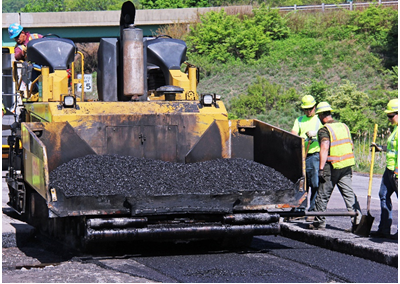Raise the Look and Feel of Your Building with Professional Commercial Parking Lot Paving
Raise the Look and Feel of Your Building with Professional Commercial Parking Lot Paving
Blog Article
Opening the Keys of Hot Mix Asphalt Modern Technology
Checking out the depths of hot mix asphalt modern technology reveals a world where precise processes and exact solutions converge to form our roads and infrastructure. The fusion of fillers, accumulations, and binders isn't merely a building and construction task but a tactical orchestration of toughness and efficiency.
Importance of Warm Mix Asphalt
Warm Mix Asphalt plays a vital duty in contemporary framework development as a result of its durability and cost-effectiveness. As one of the most typically utilized paving material for roadways, freeways, and vehicle parking lots, Warm Mix Asphalt provides a series of benefits that add to its relevance in construction tasks. One key benefit is its ability to hold up against heavy website traffic loads and rough climate problems, offering a trustworthy and lasting surface area for transportation networks. Furthermore, Warm Mix Asphalt is cost-effective in both first construction and long-lasting maintenance, making it a recommended selection for lots of framework tasks.
The longevity of Warm Mix Asphalt originates from its make-up, that includes accumulations, binder, and filler materials that are thoroughly selected and blended to fulfill details efficiency requirements. This exact combination results in a strong and flexible pavement that can endure constant use without significant deterioration. Moreover, Warm Mix Asphalt is 100% recyclable, additional enhancing its sustainability and ecological benefits. Overall, the significance of Warm Mix Asphalt in facilities development can not be understated, as it remains to be a keystone of modern construction methods.
Parts of Asphalt Mixes
The structure of asphalt blends is composed of thoroughly selected accumulations, binder, and filler products that are essential for accomplishing specific efficiency requirements. Aggregates are the main component of asphalt mixes, providing toughness and security. The binder, typically bitumen or asphalt concrete, holds the aggregates together and gives flexibility and toughness to the mix.
The mix and proportion of these parts play a considerable function in establishing the quality and efficiency of the asphalt mix. Designers meticulously create the mix to satisfy details demands, taking into consideration aspects like web traffic quantity, climate problems, and pavement life expectancy. Correct selection and balancing of accumulations, binder, and fillers are important for creating resilient, durable asphalt sidewalks.
Mixing and Production Strategies

Once the aggregates are selected, the binder, often asphalt concrete, is included to bind the products with each other. The binder's high quality and amount substantially influence the mix's versatility, toughness, and resistance to ecological factors. Additionally, fillers like hydrated lime or Portland cement might be included to enhance particular features of the asphalt mix, such as its workability or wetness resistance.
Throughout production, the accumulations and binder are heated, normally between 250-325 ° F(121-163 ° C ), to help with blending and ensure correct coating of the aggregates. The blending procedure Get More Info should be thorough to accomplish a homogeneous blend that promotes the wanted efficiency features of the asphalt. Various techniques, such as set blending or drum mixing, are used to achieve premium and consistent asphalt blends for building and construction projects.
Elements Affecting Asphalt Efficiency
Elements influencing asphalt efficiency incorporate a variety of variables that impact the resilience, long life, and general quality of asphalt sidewalks. One vital variable is the quality of products used in the asphalt mix.

Layout factors to consider, such as sidewalk density and drainage, are essential in ensuring the lasting performance of the asphalt sidewalk. By meticulously considering these aspects, designers and service providers can optimize asphalt efficiency and boost the service life of pavements.
Sustainable Practices in Asphalt Technology

Furthermore, the advancement of warm-mix asphalt (WMA) technologies has actually acquired traction recently. WMA permits for the manufacturing and positioning of asphalt mixes at reduced temperatures contrasted to standard hot-mix asphalt, resulting in decreased power consumption and greenhouse gas exhausts. The usage of permeable asphalt blends can aid alleviate stormwater overflow problems by permitting water to infiltrate through the sidewalk and right into the ground, advertising natural water filtration and recharge processes. By implementing these sustainable practices, the asphalt industry can add to constructing a much more resilient and eco friendly infrastructure network.
Verdict
In final thought, warm mix asphalt innovation plays a vital role in contemporary facilities development because of its sturdiness and cost-effectiveness. By very carefully balancing components, check here using proper mixing methods, and thinking about different factors, designers can develop high-grade asphalt mixes that hold up against rush hour tons and harsh weather. Welcoming lasting techniques, such as using warm-mix modern technologies and recycled products, further boosts the ecological friendliness of asphalt technology.
Blending and manufacturing techniques in warm mix asphalt modern technology involve the exact mix and handling of aggregates, binder, and fillers to develop a high-performance and sturdy asphalt mix.Elements affecting asphalt efficiency incorporate a range of variables that impact the sturdiness, longevity, and total high quality of asphalt sidewalks. Sustainable practices in asphalt modern technology incorporate various campaigns intended at minimizing the ecological influence of asphalt manufacturing and paving procedures. By including recovered asphalt sidewalk (RAP) and recycled asphalt roof shingles (RAS) right into new asphalt blends, the industry can substantially decrease the intake of raw products and power, while likewise reducing garbage dump waste.
WMA allows for the production and placement of asphalt mixes at lower temperature levels compared to typical hot-mix asphalt, resulting in decreased power usage and greenhouse gas emissions.
Report this page